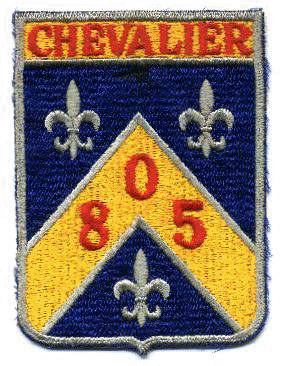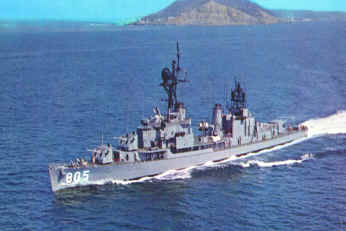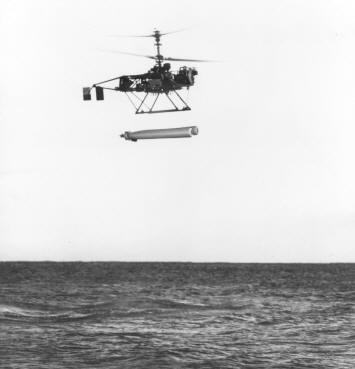|

ASW EXERCISE, SAN DIEGO OP AREA, 1966
By Richard H. King, CDR USNR-Ret.
At the time of this story, CDR King was an
Ensign in OPs (Operations)
as an EMO (Electronics Material Officer)
U.S.S. CHEVALIER (DD-805)
 By the mid to late sixties, in most exercise matches between a destroyer and a
submarine, the submarine would usually come out on top even if it was a
conventional submarine. With a nuclear submarine, it was a hopeless mismatch,
the Nuke always came out on top. In early 1966, the USS CHEVALIER DD-805 (a 1944
model Gearing) was paired against a conventional submarine for an ASW (Anti
Submarine Warfare) (and anti-destroyer, from the sub’s point of view?) exercise.
By the mid to late sixties, in most exercise matches between a destroyer and a
submarine, the submarine would usually come out on top even if it was a
conventional submarine. With a nuclear submarine, it was a hopeless mismatch,
the Nuke always came out on top. In early 1966, the USS CHEVALIER DD-805 (a 1944
model Gearing) was paired against a conventional submarine for an ASW (Anti
Submarine Warfare) (and anti-destroyer, from the sub’s point of view?) exercise.
CHEVALIER at that time was not in the “first string” for ASW,
you might call her “second string” or even “third string” ASW wise. By this
time, “VDS” (Variable Depth Sonar) was quite common and the first of the new
AN/SQS-26 sonar’s were beginning to appear in the fleet. CHEVALIER still had
only the respected but out of date AN/SQS-23 with far less range and capability.
For delivery, CHEVALIER had two triple tube trainable Mk 32 launchers launching
the Mk 44 torpedo and also had two DASH Drones (QH-50’s) that could each carry
two Mk 44 torpedoes. Due to budget problems when CHEVALIER finally went to FRAM
in 1960, she did not get ASROC. As a consolation prize, she got to keep all
three of her original gun mounts.
But sonar and torpedo delivery systems do not constitute the
entire ASW story for a destroyer. There are three other ASW systems, (1) the “Mk
5, Mod 2” eyeballs (visual sightings from lookouts, bridge watch standers and
signalmen), (2) surface search radar (in CHEVALIER’s case, the trustworthy
AN/SPS-10) and (3) ESM (electronic support measures). In CHEVALIER’s case, ESM
meant the pitifully ancient and antiquated AN/BLR-1.
As EMO (Electronic Material Officer) aboard CHEVALIER in
1966, I was sent to a two week EWS (electronic warfare school) for junior
officers. The Instructor/Chief on the first day said almost all Navy destroyers
today were equipped with the new AN/WLR-1 receiver so that is what they would
primarily teach. Some destroyers also had the new AN/ULQ-6 jamming device. I had
to raise my hand, “Chief … my ship still has the BLR-1”. He replied, “I thought
they were all scrapped … Oh well, we still have one here in the school and we
will show you how it works after classes”. “Thanks Chief!”. Ultimately, I
learned how to operate both the BLR (that CHEVALIER but no one else had) and the
WLR (that CHEVALIER didn’t have) and evaluate intercepted signals.
A quick primer in sixties vintage destroyer ESM: Both the
BLR-1 and the WLR-1 were designed to intercept the electronic transmissions of
other ships, especially their radar transmissions. Every radar transmission has
a number of identifying characteristics, including the frequency, the pulse
width, the pulse repetition rate, the antenna rotation rate, and some others.
When a radar transmission was intercepted, each characteristic could be
measured. Now by turning to a thick and clumsy book containing the
characteristics of every radar on every ship and aircraft (naval and civilian)
in the world, with persistence, time and patience, you could finally say “hey, I
think we have intercepted a Russian radar known as the “bow tie” that is found
only on the Russian Kotlin Class destroyers”. Whereupon, the two man (at GQ) ESM
team would announce “Bridge, CIC (this is) ESM, a Russian Kotlin Class Destroyer
bears 063 degrees true”. “Bridge aye”. “CIC aye”. Note that we gave the bridge
and CIC a bearing to the Kotlin, but no range. That’s because we had no accurate
way to even estimate range.
Having now graduated from EWS (electronic warfare school) I
went back to the fleet, meaning the CHEVALIER. Not long thereafter, we went to sea and I learned of the scheduled
destroyer-submarine exercise battle that was forthcoming, i.e., the mother of
all ASW/ADW (anti destroyer warfare) exercise battles between essentially a
general purpose Gearing and a conventional diesel US submarine (a/k/a, a “smoke
boat”).
long thereafter, we went to sea and I learned of the scheduled
destroyer-submarine exercise battle that was forthcoming, i.e., the mother of
all ASW/ADW (anti destroyer warfare) exercise battles between essentially a
general purpose Gearing and a conventional diesel US submarine (a/k/a, a “smoke
boat”).
But wait, there were to be some “Rules” so that the “battle
could be joined” within a reasonable period of time and so the observers and
scorers from both the submarine and destroyer squadron commodores’ staffs could
get home in time for happy hour. That was a very important consideration. So
here were the rules:
Both ships would have some “plaster load” exercise torpedoes.
If I understand “plaster load”, it was essentially a real torpedo but in lieu of
a warhead tip, had a “plaster of Paris tip” that would crumble upon impact with
the hull (of either the destroyer or the submarine). I think that after it
scored a “hit”, something inside it would also cause it to float to the surface
so it could be recovered.
A “square” twenty miles by twenty miles (?), was drawn in the
San Diego Operations Area. The submarine would start from the west side of the
square; the destroyer (CHEVALIER) would start from the east side (sort of like
in boxing). Ding, ding! Ding, ding! Let the battle begin. Under the rules of
engagement, both ships were to remain within the box and sink her respective
opponent using a “Plaster of Paris tipped” torpedo that hopefully would not
cause any actual damage to the opponent. May the best ship win! As general
quarters sounded, CHEVALIER’s tiny ESM cubicle, separated from CIC by only a
curtain, was manned by RD3 Jim Newkirk (manning the trusty BLR-1) and Ensign
Dick King (holding that big thick clumsy book). The curtain was so I could keep
a light on to read the big clumsy book without causing problems in a darkened
CIC.
CHEVALIER’s captain, G. G. Ely Kirk, really wanted to do well
in this exercise, and all the key players had been extensively briefed for days
in preparation. Key players? They would be the sonar men, torpedo men, the DASH
crew and CIC, but not Chevy’s two-man ESM team. But I had read all the message
traffic setting up the exercise and I knew the name of the American submarine.
Since I knew the name, I knew the class and using the big fat clumsy book in
reverse, I found the parameters and characteristics of her surface search radar.
I told Newkirk to search only between frequency x and frequency y (the ranges of
the submarine’s surface search radar) and forget everything else. The range
between “x” and “y” was very narrow, less than one percent of commonly used
surface search radars worldwide. Was this cheating on the exercise? I don’t
know, I didn’t ask anyone. By way of analogy, think of your FM radio dial,
typically running from 86 to 110 MHz. We are looking for an intermittent FM
broadcast and we know that if it broadcasts, it will be on not less than 96.3
MHz nor more than 96.5 MHz. Our search problem is greatly simplified.
Submarines as far as possible like to be stealthy and usually
maintain strict “EMCON” (Emission Control). When the periscope mounted surface
search radar is used, typically the captain will order just one or two sweeps
(transmitting for only one or two rotations of the antenna, just a few seconds).
Five minutes after COMEX (Commence Exercise), in a decision I suspect he
regretted for a long time, the submarine captain decided to risk a two sweep
radar “peek” to locate CHEVALIER. Suddenly Newkirk said, “There it is, frequency
“x”, pulse repetition rate “y”, pulse width “z”. “Bearing 265”. BINGO, and then
it was gone. I said, “report it to the bridge and CIC” (Newkirk was wearing
sound powered phones on the JA (?) circuit). He did so, “Bridge-CIC (this is)
ESM, target submarine bears 265 true”.
I heard later that the reaction on the bridge, in CIC and in
sonar was one of incredulous doubt. It (the exercise) was apparently not
supposed to work this way. Some people weren’t even aware that ESM could have a
role in ASW. Suddenly the curtain to ESM was whipped open and there stood the
OPS officer, LT Jim Brink, demanding, “are you sure? … Are you sure?” I replied,
“Yes sir, we are sure” as Newkirk nodded his head indicating he agreed.
 Captain Kirk wasted no time cross-examining his two-man ESM team;
I doubt if he even knew who was on it. He immediately ordered a DASH in the air
and sent it out the bearing we had reported with orders to stop it short of the
edge of the specified exercise area (remember, we give bearings only, no ranges,
so he was using the Op Area limit as a temporary maximum range). At the same
time, he ordered CHEVALIER on the course of the reported bearing and at a rather
high rate of speed at first (sonar performance is seriously degraded by high
speed).
Captain Kirk wasted no time cross-examining his two-man ESM team;
I doubt if he even knew who was on it. He immediately ordered a DASH in the air
and sent it out the bearing we had reported with orders to stop it short of the
edge of the specified exercise area (remember, we give bearings only, no ranges,
so he was using the Op Area limit as a temporary maximum range). At the same
time, he ordered CHEVALIER on the course of the reported bearing and at a rather
high rate of speed at first (sonar performance is seriously degraded by high
speed).
So far CHEVALIER had been lucky. Using some guesswork and
intuition, the Captain at some point slowed CHEVALIER and almost immediately
thereafter a sonar contact was acquired on the SQS-23 and
reported. BINGO again, and again Kirk wasted no time screwing around. He
immediately sent the DASH to the “datum” and ordered an Mk 44 dropped.
The Mk 44 was a homing torpedo; it quickly acquired its target and made a direct
hit on the submarine. But Kirk was not done yet, he was still charging towards
datum and ordered a second Mk 44 fired out of one of the triple launchers.
Shortly thereafter a second direct hit was obtained on the
submarine.
The score at this point was CHEVALIER two, submarine zero,
and the exercise was declared over. It was just one of those rare days when
every piece of equipment (BLR-1, AN/SQS-23, QH-50, Mk 32 launcher and Mk 44
torpedoes) and all personnel involved therewith, worked perfectly, exactly as
designed and trained The exercise planners and scorers had expected an exercise
that would last for several hours but the whole thing was over in less than 40
minutes. CHEVALIER was given a score of 98 (out of 100) on the exercise
(something stupid like a sailor forgetting to tuck his pants into his socks at
GQ cost us a perfect score). CHEVALIER did however receive the ASW “A” that
cycle.

 

|
